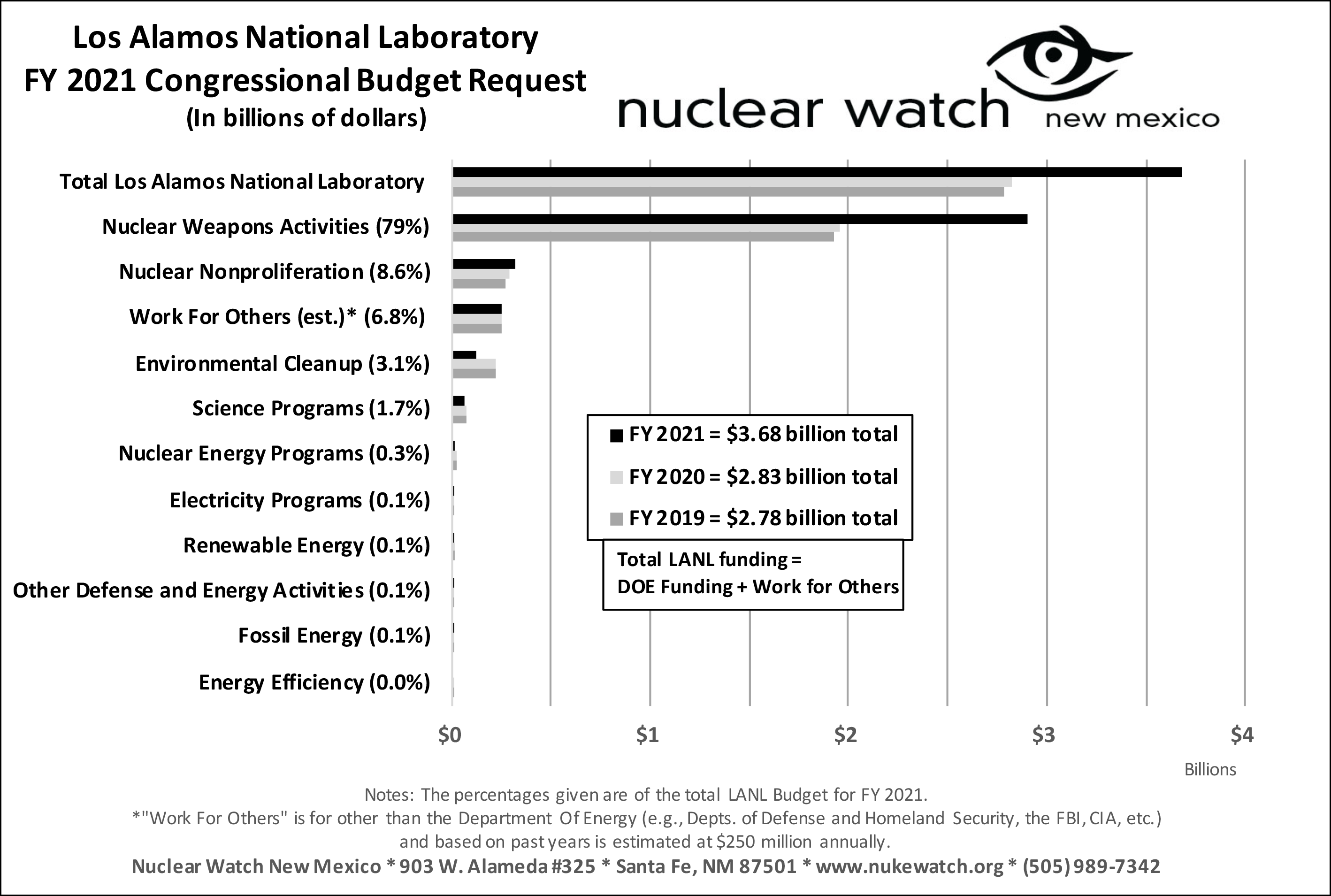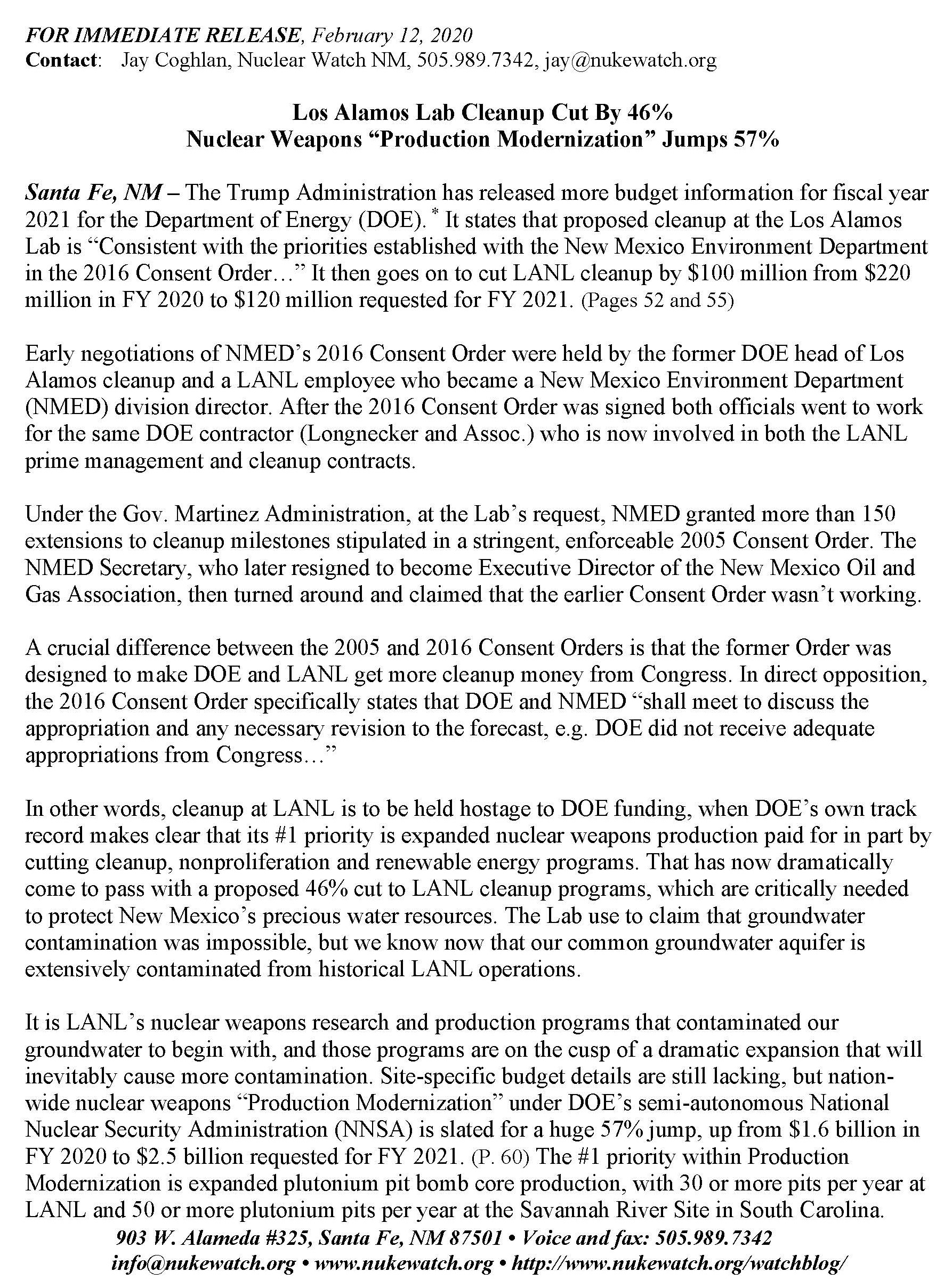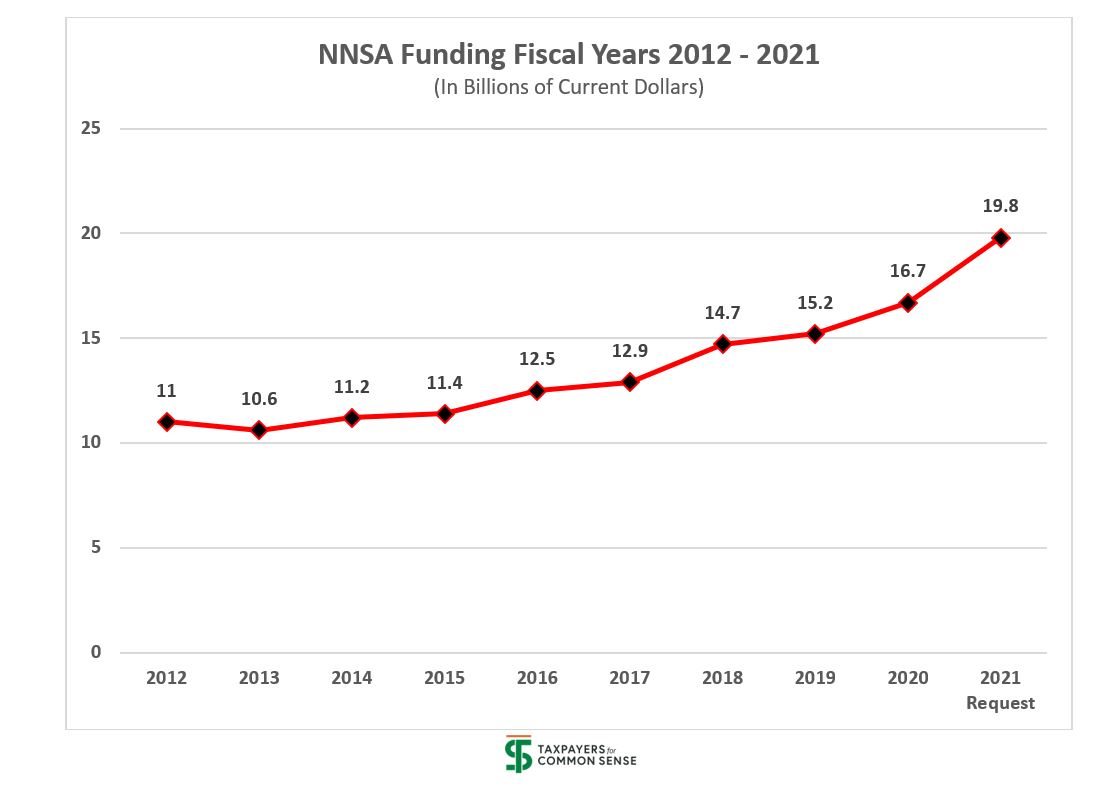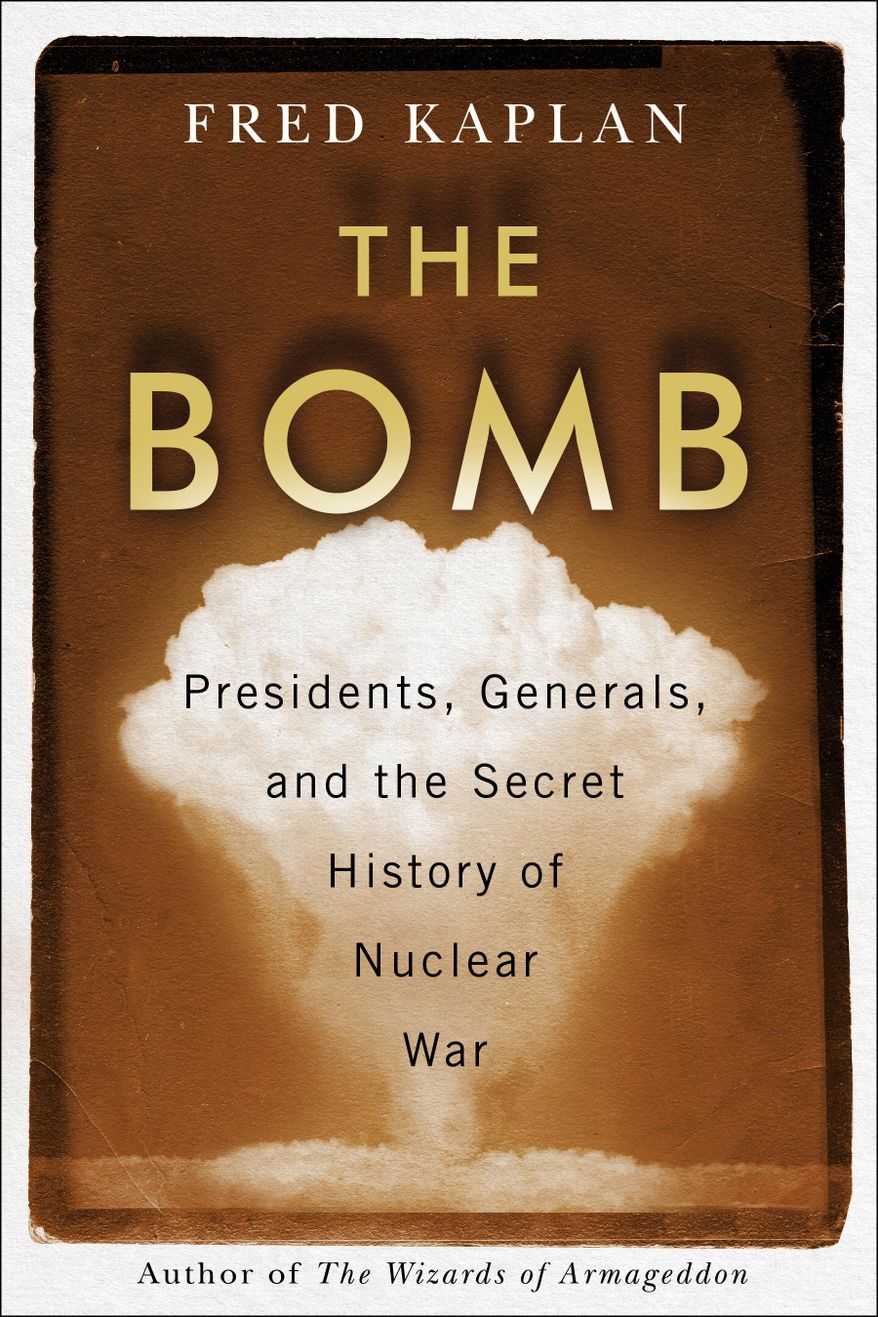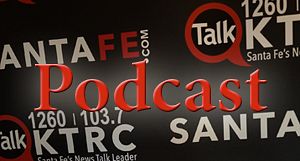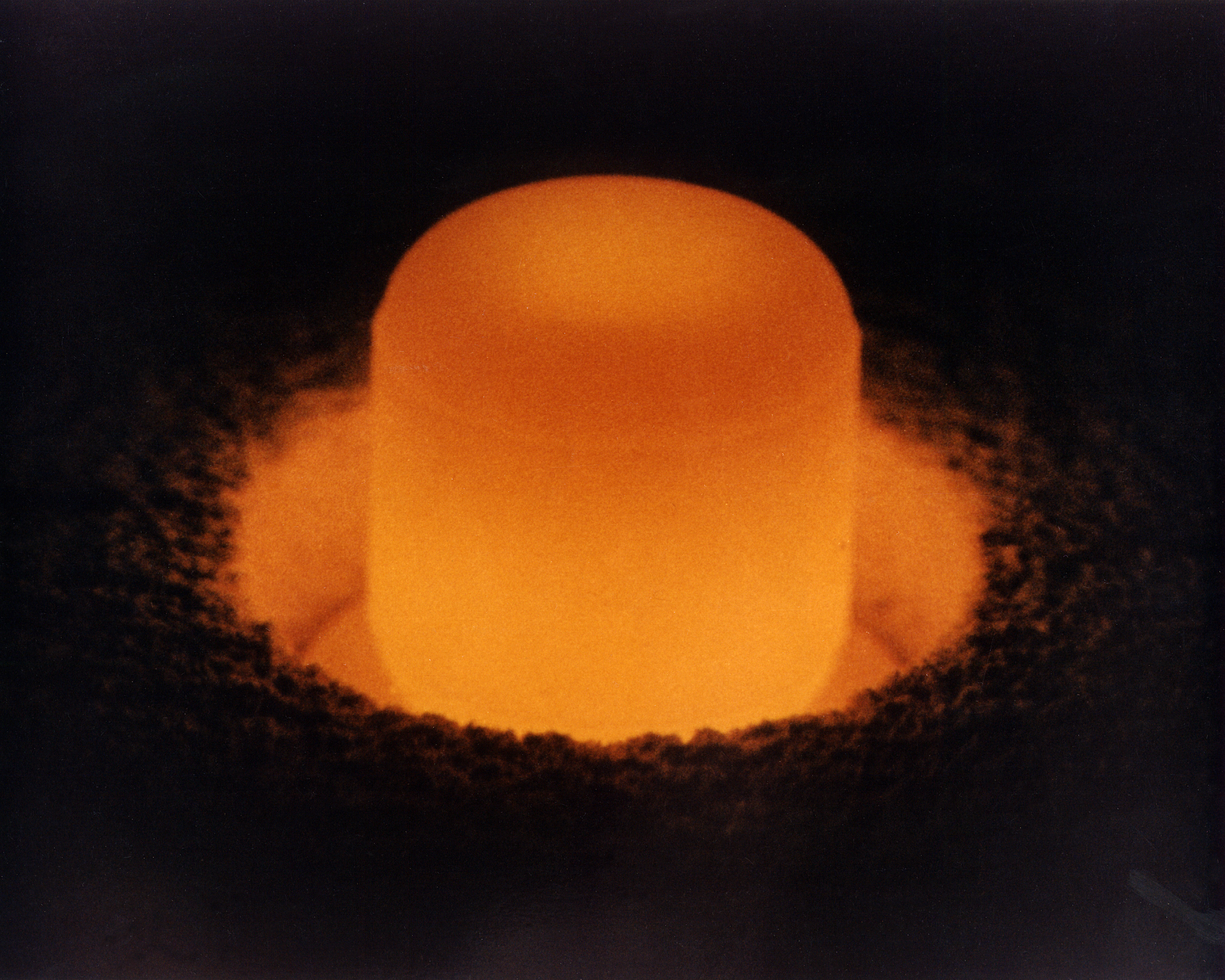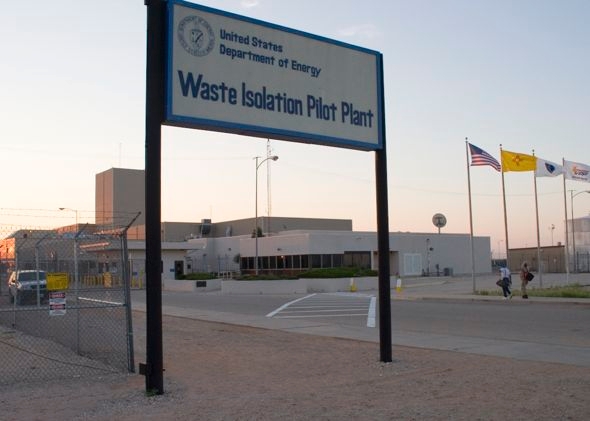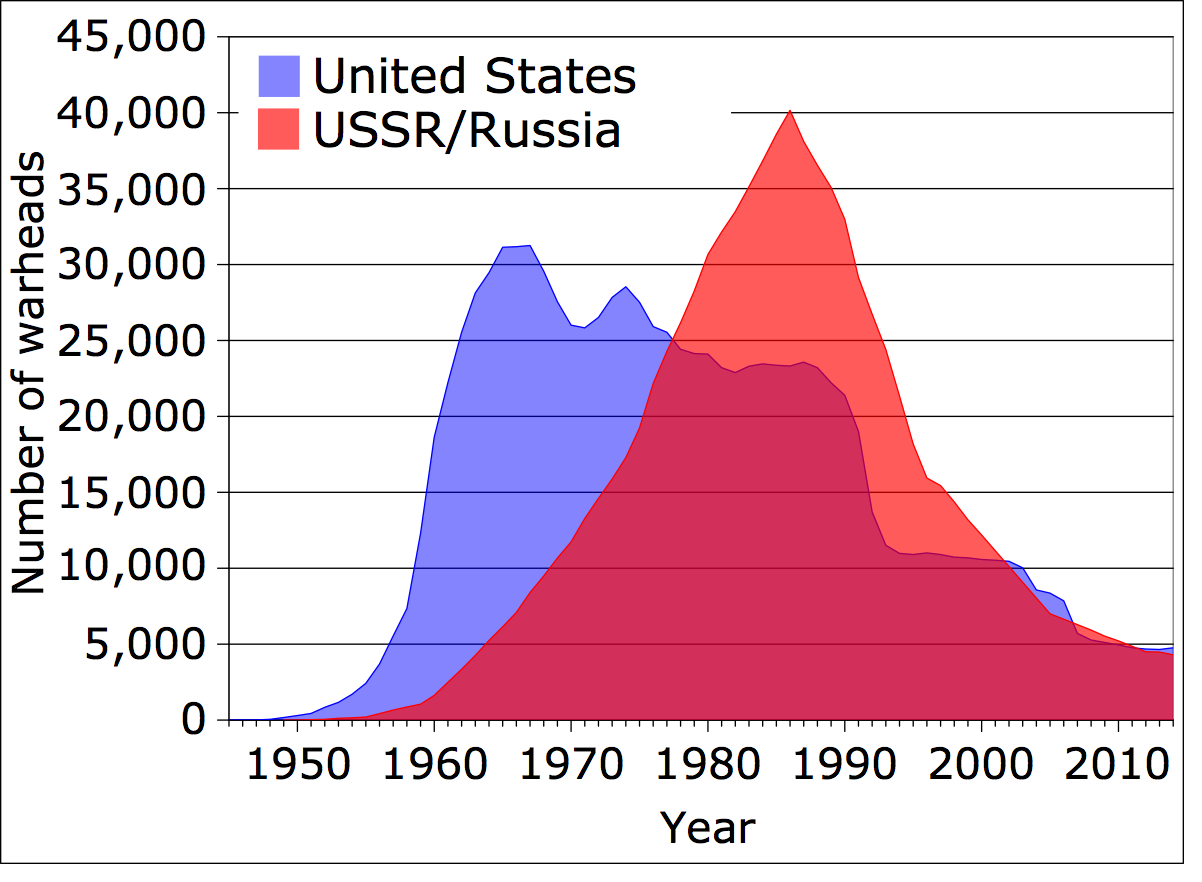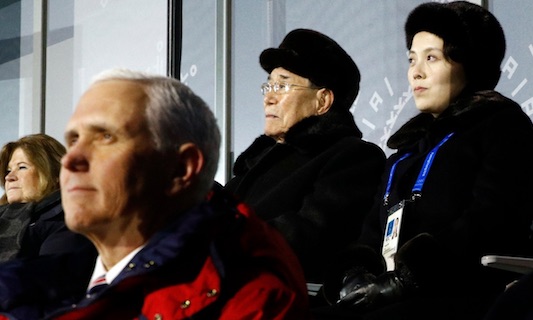2020
Requested NNSA FY 2021 Funding for “Primary Capability Modernization”
(i.e. plutonium pits)
Bottom line: The National Nuclear Security Administration (NNSA) has requested $1.58 billion for expanded plutonium pit production in FY 2021 alone, when at least 15,000 pits are already stored at the Pantex Plant and independent experts have concluded that pits last at least a century (the average age now of pits in the active stockpile is less than 40 years). NNSA’s request is more than doubled from $712.4 million in FY 2020 for the comparable program “Plutonium Sustainment” that preceded Primary Capability Modernization.
No plutonium pit production is scheduled to maintain the safety and reliability of the existing stockpile. Instead, future pits will likely be heavily modified from tested designs for use in speculative new-design nuclear weapons. This could raise reliability issues and/or prompt the US to resume full-scale nuclear weapons testing.
Inside America’s newly revealed nuclear ballistic missile warhead of the future
“NNSA already has too much work on its plate to sustain. Accelerating development of yet another excessively ambitious program will only make that problem worse,” – Kingston Reif of the Arms Control Association
BY: AARON MEHTA | defensenews.com
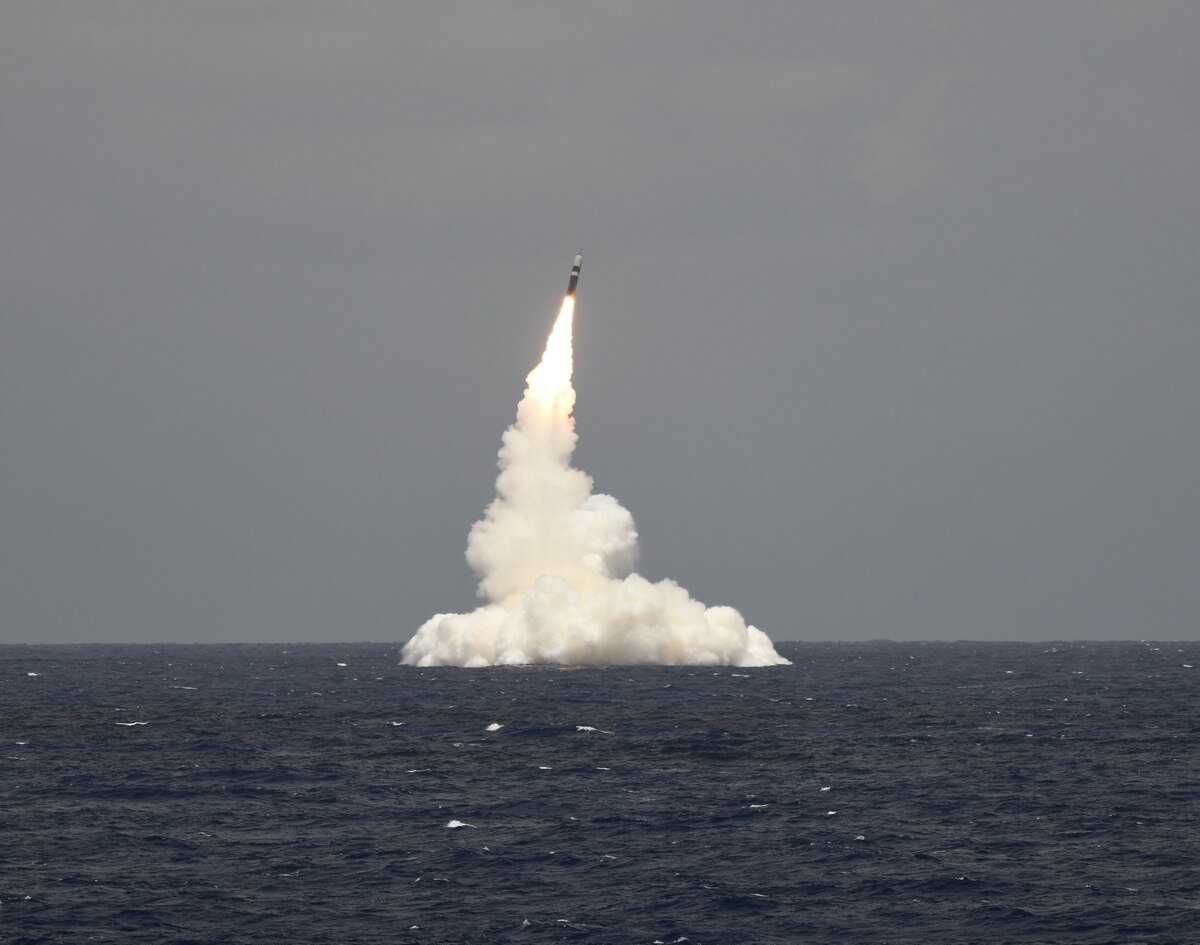
MINOT AIR FORCE BASE, N.D. — When the Trump administration’s budget request rolled out Feb. 10, eyebrows shot up within the nuclear community at the mention of a previously unknown warhead, listed in documents as the W93.
Now the Pentagon is revealing details about the weapon, what it will replace and when it might be deployed.
The labeling of the warhead as the W93 is important. Since the introduction of the W88 in the 1980s, all upgrades to warheads have been described as variants — for instance, the collapsing of several versions of the B61 gravity bomb into the B61-12. According to a senior defense official, the reason for the new designation comes from the reality that the warhead is largely a new design.
“This destabilizing deployment further increases the potential for miscalculation during a crisis,”
House Armed Services Committee Chairman Adam Smith (D-Wash.), an opponent of the Trump Administration’s Nuclear Posture Review report’s call for new low-yield warhead capabilities, on the decision to deploy the W76-2. He further described it as “misguided and dangerous.” — armscontrol.org

U.S. Deploys Low-Yield Nuclear Warhead – Shannon Bugos
The U.S. Navy has fielded a low-yield nuclear warhead for some of its submarine-launched ballistic missiles for the first time, the Defense Department confirmed in February.
Feinstein, Colleagues to DOD: ‘Low-Yield’ Nuclear Weapons Not a Deterrent
PRESS RELEASE | feinstein.senate.gov
Washington—Senators Dianne Feinstein (D-Calif.), Patrick Leahy (D-Vt.), Bernie Sanders (I-Vt.), Tammy Baldwin (D-Wis.) and Elizabeth Warren (D-Mass.) today wrote to Defense Secretary Mark Esper questioning the decision to begin fielding W76-2 “low-yield” nuclear submarine-launched ballistic missile warheads.
“We write to express our concern about the recent decision to begin fielding the W76-2 low-yield nuclear submarine-launched ballistic missile warhead, a decision we do not support,” wrote the senators.
“It is inconsistent for the United States to begin fielding new nuclear weapons while we urge other countries not to do so. We should be focusing on diplomatic solutions, and we ask that you urge President Trump to extend New START before it expires next year in order to begin negotiating a successor treaty that addresses U.S. security needs.”
Full text of the letter is available here and below.
Senators Introduce Legislation to Counteract Trump Exit from Iran Deal
Iran Diplomacy Act calls for a diplomatic resolution to Iran’s nuclear program
PRESS RELEASE | markey.senate.gov
Washington (February 19, 2020) – Senators Edward J. Markey (D-Mass.), Dianne Feinstein (D-Calif.), Chris Van Hollen (D-Md.), Tammy Duckworth (D-Ill.), Bernie Sanders (I-Vt.), and Elizabeth Warren (D-Mass.) have introduced S.3314, the Iran Diplomacy Act, which calls upon the United States and Iran to return to no less than their commitments under the 2015 Joint Comprehensive Plan of Action (JCPOA), also known as the Iran nuclear deal. On January 14, 2020, France, Germany, and the United Kingdom triggered the JCPOA’s Dispute Resolution Mechanism in an attempt to address Iran’s breaches of the agreement, all of which followed the Trump administration’s unilateral exit from the deal on May 8, 2018.
Holes found in protective liner at SC nuclear fuel factory
Inspectors at the Westinghouse nuclear fuel factory near Columbia recently found 13 small leaks in a protective liner that is supposed to keep pollution from dripping into soil and groundwater below the plant.
ARTICLE BY SAMMY FRETWELL | thestate.com
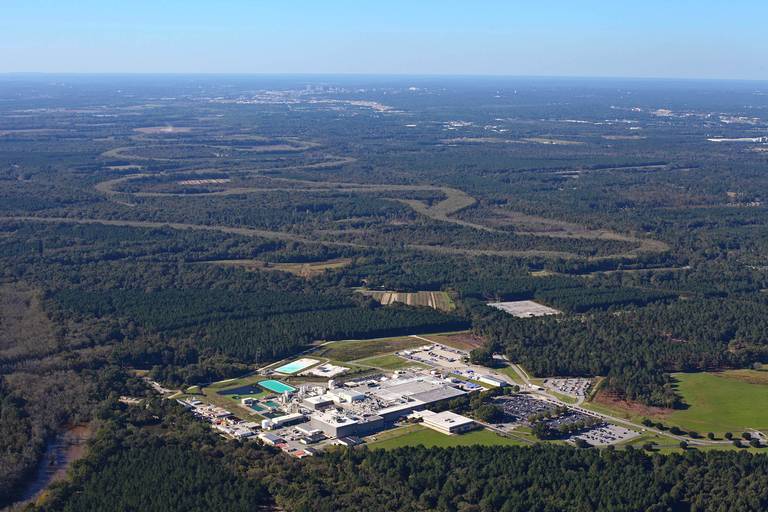
Now, the company plans to check a concrete floor beneath the liner, as well as soil below the plant, for signs of contamination that could have resulted from the tears, which were characterized in a federal inspection report as ‘’pinhole leaks.’’ The pinhole leaks, discovered by Westinghouse late in 2019, may have formed after company employees walked across the liner and weakened it, according to the U.S. Nuclear Regulatory Commission.
“[Even] a “limited” India-Pakistan nuclear war would significantly affect every person on the globe, be they a school teacher in Nebraska, a factory-worker in Shaanxi province or a fisherman in Mombasa.”
Sebastien Roblin — nationalinterest.com
“Nowhere On Earth Would Be Safe From An India-Pakistan Nuclear War”

The India-Pakistan conflict is the world’s most dangerous.
India’s official policy is that it will never be first to strike with nuclear weapons—but that once any nukes are used against it, New Dehli will unleash an all-out retaliation.
Proposed budget calls for $100 million cut in LANL cleanup
“To have a 46 percent cut in Los Alamos cleanup is stunning,” said Jay Coghlan, executive director of Nuclear Watch New Mexico. “We’ve got nuclear weapons on steroids and cleanup is the poor stepchild subject to the whims of DOE.”
BY: Scott Wyland [email protected] Feb 13, 2020 | Santa Fe New Mexican
Los Alamos National Laboratory’s long-term environmental cleanup program would be cut by $100 million under the U.S. Energy Department’s proposed budget for 2021.
The agency’s preliminary “budget in brief” shows a proposed 46 percent reduction in funding for the lab’s environmental management, which handles cleanup of legacy waste generated before 1999, including during the Manhattan Project and Cold War.
A mile-long, highly toxic chromium plume under the Sandia and Mortandad canyons and the massive radioactive waste buried in Area G are the results of shoddy disposal that occurred around the lab before environmental regulations were enacted in the 1970s.
Meanwhile, the Energy Department wants to increase spending by 25 percent on nuclear weapons to help meet the Trump administration’s goal of having LANL and Savannah River Site in South Carolina produce a combined 80 plutonium pits a year by 2030.
Los Alamos Lab Cleanup Cut By 46%, Nuclear Weapons “Production Modernization” Jumps 57%
FOR IMMEDIATE RELEASE, February 12, 2020
Contact: Jay Coghlan, Nuclear Watch NM, 505.989.7342, jay[at]nukewatch.org
Santa Fe, NM – The Trump Administration has released more budget information for fiscal year 2021 for the Department of Energy (DOE). * It states that proposed cleanup at the Los Alamos Lab is “Consistent with the priorities established with the New Mexico Environment Department in the 2016 Consent Order…” It then goes on to cut LANL cleanup by $100 million from $220 million in FY 2020 to $120 million requested for FY 2021. (Pages 52 and 55)
Nuclear waste site near Carlsbad opposed by New Mexico House committee vote
“These wastes are going to last for millions and millions of years. They are extremely toxic. The idea is to dispose of these in an area where there are gas and mineral resources. This is really not what New Mexico needs.” – Dave McCoy with Citizen Action New Mexico
ARTICLE BY: ADRIAN HEDDEN | currentargus.com
Legislation to oppose the transportation and storage of high-level nuclear waste in New Mexico cleared a State House committee as Holtec International continues to develop a plan to store such waste at a proposed facility near the Eddy-Lea county line.
House Memorial 21 was introduced by New Mexico Rep. Matthew McQueen (D-50) intended to prevent the controversial proposal that could see up to 100,000 metric tons of spent nuclear fuel rods stored on a temporary basis at the site in southeast New Mexico for at least 40 years.
Trump’s FY 2021 DOE Nuclear Weapons Budget Sets Post-Cold War High – New Nuclear Warhead Is Planned
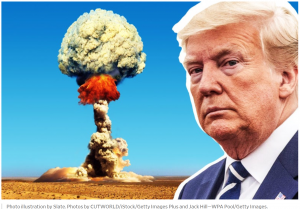
Today the Trump Administration released topline budget numbers for fiscal year 2021 for the Department of Energy (DOE). This includes DOE’s semi-autonomous National Nuclear Security Administration (NNSA), whose nuclear weapons programs are slated to receive the highest amount of taxpayer dollars since the Cold War ended nearly 30 years ago.
This year 2020 marks the 75th anniversaries of the atomic bombings of Hiroshima and Nagasaki and the 50th anniversary of the Non-proliferation Treaty (NPT), which is commonly regarded as the cornerstone of international nuclear weapons nonproliferation. The NPT required the established nuclear powers to enter into serious negotiations leading to global nuclear disarmament, which they ignored. 2020 also marks the third anniversary of a nuclear weapons ban treaty that needs only 16 more nations to ratify before it goes into effect. The U.S. and other nuclear weapons powers vigorously oppose that ban treaty even as their “modernization” programs are fueling a new nuclear arms race and international arms control is collapsing.
The Trump Administration’s FY 2021 Request for the National Nuclear Security Administration
The Trump Administration is proposing a massive funding increase for the Department of Energy’s National Nuclear Security Administration (NNSA). At $19.8 billion, the request increases current NNSA funding by $3.1 billion, or 18.4 percent.
Article originally from taxpayer.net
NNSA funds all the Pentagon’s nuclear weapons-related activities, including weapons design, production, safeguarding the nation’s nuclear stockpile and clean-up of the government’s nuclear weapons sites. The NNSA budget does not fund the aircraft, submarines and missiles that make up the military’s nuclear “triad,” which are funded within the Pentagon’s annual budget.
In the FY 2021 request, the Department of Energy states that the additional NNSA funding is necessary to support the modernization efforts of U.S. nuclear forces called for in the 2018 Nuclear Posture Review.
Trump Proposes 25 Percent Bump in Nuke Spending
“Taxpayers in 2020 should not be forced to pay for a ticket back to nuclear weapons policies of the 1980s,” John Tierney, executive director of the Center for Arms Control and Non-Proliferation, said in a statement. Pit production funding wasn’t included in the overview. Energy Department officials said a full budget proposal would become available in the coming weeks.
“Globally, Trump’s nuclear weapons budget is fueling a new nuclear arms weapons race, particularly with a new plan for a new nuclear warhead,” said Jay Coghlan, executive director of New Mexico Nuclear Watch. “It solidifies Los Alamos lab’s future as a nuclear bomb plant, especially while nonproliferation, renewable energy and cleanup programs are held flat or cut.”
BY: SCOTT WYLAND |santafenewmexican.com
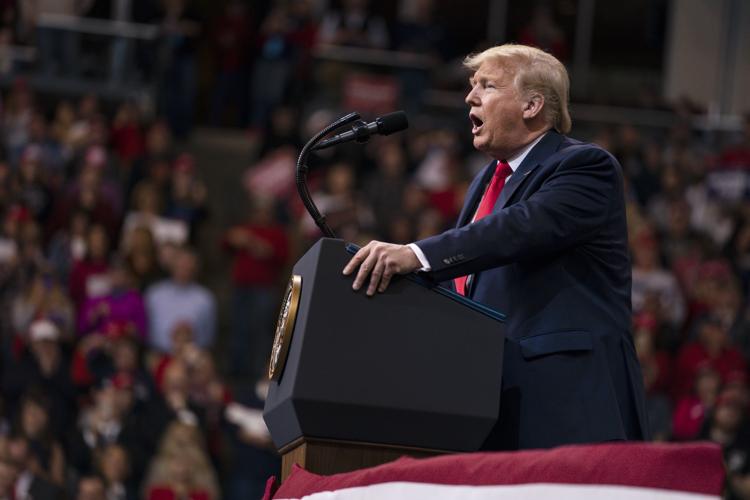
President Donald Trump is proposing a 25 percent increase in nuclear weapons spending that will include developing a new warhead for submarine-launched ballistic missiles, according to a preliminary 2021 budget overview released Monday.
The National Nuclear Security Administration, a semi-autonomous branch of the U.S. Energy Department, would see its budget increase by 18.4 percent to $19.8 billion next fiscal year, partly to ramp up production of plutonium pits at Los Alamos National Laboratory and Savannah River Site in South Carolina.
President’s Budget Calls for More Spending on Nuclear Production
Jay Coghlan of Nuclear Watch New Mexico, says that the budget request would allocate more taxpayer dollars to the country’s nuclear weapons programs since the Cold War ended 30 years ago.
“Globally Trump’s nuclear weapons budget is fueling a new nuclear arms race,” he said in a statement. “It solidifies Los Alamos Lab’s future as a nuclear bomb plant, while nonproliferation, renewable energy and cleanup programs are held flat or cut.”
BY: T.S. LAST |abqjournal.com
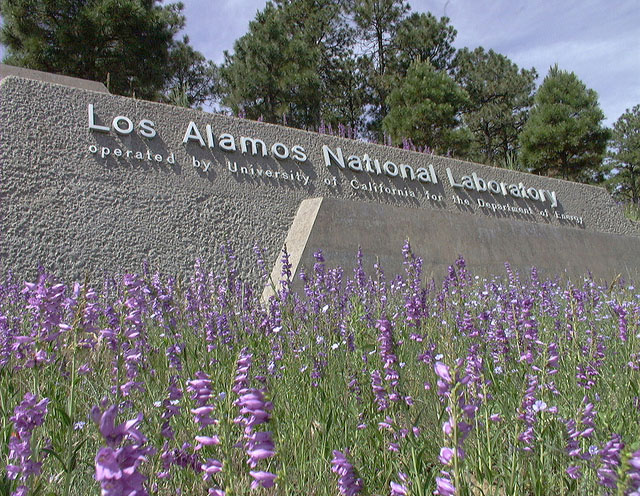
SANTA FE, N.M. — The National Nuclear Security Administration would get $19.8 billion under President Trump’s budget request for fiscal year 2021 — a 20% increase from this year’s budget — about half of which would go toward supporting the U.S.’s nuclear weapons programs.
According to a Department of Energy fact sheet distributed on Monday, $9.5 billion of NNSA’s budget would be put toward efforts to “sustain and modernize the U.S. nuclear stockpile.” Of that, $4.3 billion is earmarked for stockpile management and $2.5 billion is for production modernization to support production capabilities for nuclear weapons. That includes funds for equipment, facilities and personnel “to reestablish the Nation’s ability to produce (plutonium) pits.”
Trump Budget Calls for New Nuclear Warheads and 2 Types of Missiles
The president’s spending proposal requests money for a new arms race with Russia and China, and restores nuclear weapons as central to military policy.
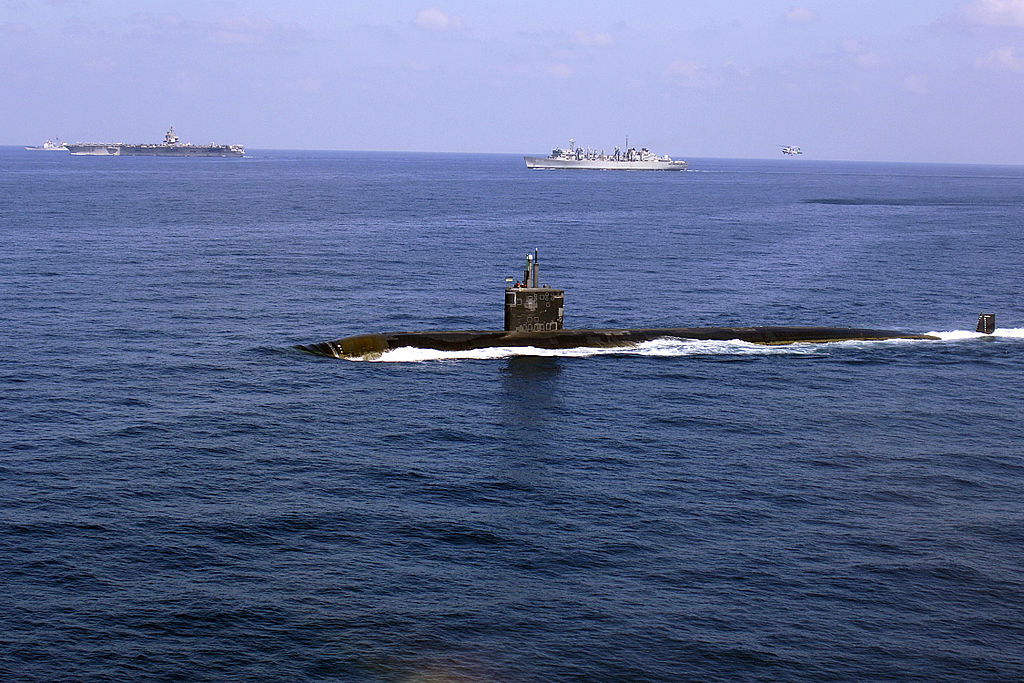
WASHINGTON — The Trump administration has begun to put a price tag on its growing arms race with Russia and China, and the early numbers indicate that restoring nuclear weapons to a central role in American military strategy will cost tens of billions of dollars over the next decade.
In the 2021 budget released on Monday, the administration revealed for the first time that it intended to create a new submarine-launched nuclear warhead, named the W93. Its development is part of a proposed 19 percent increase this year, to $19.8 billion, for the National Nuclear Security Administration, the Energy Department agency that maintains the nuclear stockpile and develops new nuclear warheads. More tellingly, that is a jump of more than 50 percent since 2017, President Trump’s first year in office.
Report: Triad had serious deficiencies in first year running Los Alamos lab
This article from the Santa Fe New Mexican is based on NNSA’s annual Performance Evaluation Reports (PERs) on contractor performance at its 8 nuclear weapons sites. NukeWatch New Mexico successfully sued in 2012 to get these reports publicly released. However, NNSA is now releasing only 3-page summaries, citing security concerns to at least one reporter. This is a baseless excuse given there has never been anything classified in the PERs.
“The federal evaluation points to Triad’s repeated breakdowns in oversight and safety issues while declaring that the contractor’s so-called accomplishments only slightly outweighed these chronic issues,” Jay Coghlan, executive director of Nuclear Watch New Mexico, said in a statement. “A rating of ‘good’ is simply not good enough as the lab aggressively expands the production of radioactive plutonium bomb cores for the new nuclear arms race,”
BY: SCOTT WYLAND | santafenewmexican.com
The consortium of nonprofits that operates Los Alamos National Laboratory struggled with safety, security and waste-management problems during the first year of its contract, including the accidental release of highly flammable cesium that required a multimillion-dollar cleanup, said an annual federal report card.
Putin wants to extend arms control. What’s Trump waiting for?
“Arms control takes political willpower. Binding and verifiable treaties are worth the effort. The weapons themselves are as cataclysmic in their power as ever. Have we lost the willpower to keep them in check?”
EDITORIAL BOARD | washingtonpost.com
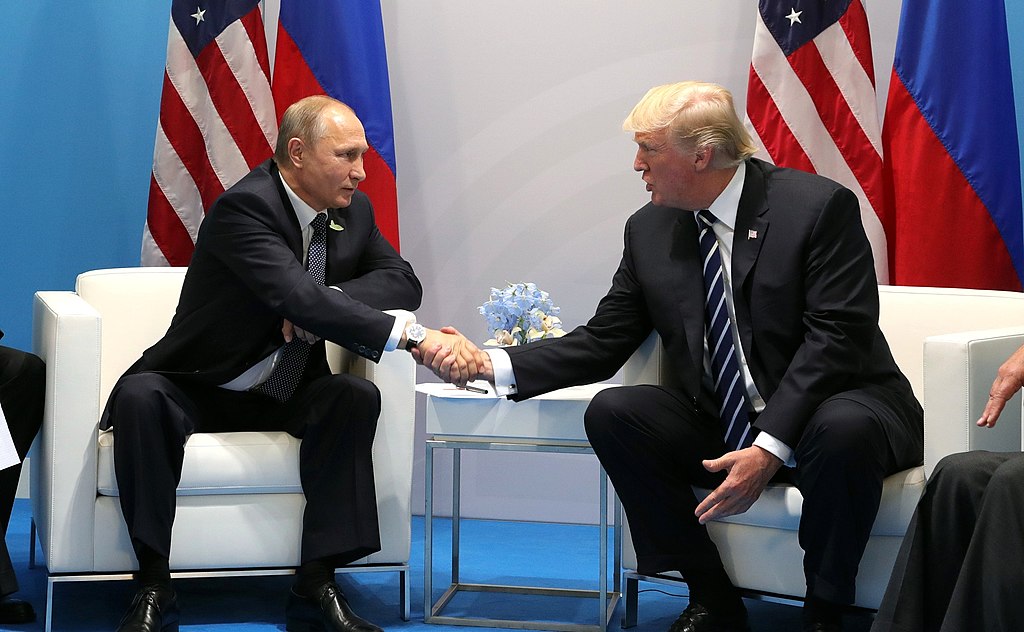
The clock is ticking toward expiration of the last major nuclear arms control treaty, New Start, which will end a year from now if not extended by the United States and Russia. Should it lapse, the path will be open to another dangerous arms race, hardly what the world needs. Right now, all signs are pointing in the wrong direction.
WIPP Notes Need for Infrastructure Upgrades
DOE hopes to ramp up shipments of nuclear waste to NM repository
BY: ADRIAN HEDDEN | abqjournal.com
Officials from the U.S. Department of Energy are hoping to ramp up shipments of nuclear waste to the Waste Isolation Pilot Plant near Carlsbad to about 17 per week by 2023. The facility is currently accepting about 10 per week. To meet the goal of increasing shipments, Acting Manager of the DOE’s Carlsbad Field Office Greg Sosson said numerous ongoing infrastructure upgrades at the facility were needed.
“Infrastructure ages. We understand we have a lot more waste stream we’re going to tackle,” Sosson said. “These are really good projects to make sure WIPP is sustainable in the future so we can perform our important mission.”
Sosson, at Monday’s annual WIPP Legislative Breakfast in Santa Fe, said officials plan on WIPP accepting up to 350 shipments of transuranic nuclear waste in the next year from numerous DOE facilities, including 80 from Los Alamos National Laboratory and 195 from Idaho National Laboratory.
But to continue to accept waste at an increasing pace, Sosson said the facility must solve its airflow problem.
Trump takes Yucca Mountain off the table. What’s that mean for San Onofre nuclear waste?
“The proposed $3.1 billion increase for weapons is simply sprinting toward failure, and Congress should right-size NNSA’s workload to match what the complex can realistically do,” – Rep. Marcy Kaptur, D-Ohio
ARTICLE BY: ROB NIKOLEWSKI | latimes.com
President Trump has made a U-turn on funding the long-delayed and long-debated Yucca Mountain nuclear waste repository in Nevada — but it’s unclear what his decision means for moving the 3.55 million pounds of spent nuclear fuel at the shuttered San Onofre nuclear power plant.
In a tweet Thursday, Trump wrote:
Nevada, I hear you on Yucca Mountain and my Administration will RESPECT you! Congress and previous Administrations have long failed to find lasting solutions – my Administration is committed to exploring innovative approaches – I’m confident we can get it done!
— Donald J. Trump (@realDonaldTrump) February 6, 2020
A White House official confirmed that the administration will not include any funding for Yucca Mountain when it turns in its proposed 2021 budget next week.
Media Advisory: What to Look For in the U.S. Department of Energy’s FY2021 Nuclear Weapons and Cleanup Budget Request

According to media reports, the National Nuclear Security Administration (NNSA), the semiautonomous nuclear weapons agency within the Department of Energy (DOE), has persuaded President Trump to increase its weapons budget by more than 20% in one year. NNSA Administrator Lisa Gordon-Hagerty has claimed that a failure to give her agency that huge increase would amount to “unilateral disarmament” despite the U.S. having thousands of nuclear warheads ready to launch on a moment’s notice.
The Alliance for Nuclear Accountability, a 33-year-old network of groups from communities downwind and downstream of U.S. nuclear weapons sites, strongly opposes this unnecessary and dangerous spending that promotes a new global nuclear arms race. In addition, Trump’s FY 2021 budget request is expected to cut or hold flat cleanup, nonproliferation, dismantlement and renewable energy programs that meet real national needs to pay for more unneeded nuclear weapons. To compound all this, DOE’s nuclear weapons and environmental management programs have been on the Government Accountability Office’s “High Risk List” for project mismanagement and waste of taxpayers’ dollars for 27 consecutive years.
Communities Push Back Against Reports of Huge Nuclear Weapons Budget Increase

Multiple sources indicate the FY2021 budget request from the Trump Administration will seek a dramatic increase in funding for nuclear weapons—an unprecedented leap of 20% over current spending levels, bringing the total for The National Nuclear Security Administration to $20 billion. Reportedly, the increase is earmarked principally for modernization programs for warhead design and plutonium pit manufacturing facilities. News reports have included outlandish statements from NNSA Administrator Lisa GordonHagerty who suggested providing any less that $20 billion would amount to “unilateral disarmament,” a claim no truer than the since discredited declaration of a missile gap with the Soviets in 1962.
The Alliance for Nuclear Accountability, a nationwide coalition of grassroots watchdog groups from every major US nuclear weapons facility, notes that the current US nuclear stockpile has been certified reliable and is expected to be reliable for at least forty more years. ANA released a letter to Congressional leadership calling for a hard look at the budget request when it arrives, scheduled for February 10, and encouraging House and Senate members to reject the increase as unjustified and unwise.
“The United States retains possession of nearly 4,000 stockpiled and deployed nuclear warheads and bombs. This is hardly disarmament,” said Marylia Kelley, executive director of Tri-Valley CAREs in Livermore, California. “Moreover, a 20% increase for weapons activities would perilously escalate an already dangerous new arms race. Rather than speed the design and production of new warheads, such as the W87-1, the country would be better served by cleaning up the contamination impacting our communities from the
first cold war. ”
ANA has tracked spending on nuclear weapons programs for more than thirty years.
Saugeen Ojibway Nation votes no on deep geologic repository at Bruce Power
A Win for Canadian Tribal Communities: The site at Bruce Power was to be Canada’s first geologic repository, but it has been stopped because the First Nation Saugeen Ojibways voted NO, and the company (Ontario Power Generation) agreed to proceed only with tribal approval.
BY: ADAM BELL | blackburnnews.com

Members of the Saugeen Ojibway Nation have voted against a proposal to host a deep geologic repository at Bruce Power.
Out of 1,232 total votes, just 170 voted “yes”, while 1,058 voted “no”, with four spoiled ballots.
In a release, Chief Lester Anoquot says “This vote was a historic milestone and momentous victory for our People. We worked for many years for our right to exercise jurisdiction in our Territory and the free, prior and informed consent of our People will be recognized”.
Ontario Power Generation spokesperson Fred Kuntz says “OPG respects the decision of the SON community. We followed SON’s process. So we will uphold our 2013 commitment not to proceed with the DGR at the Bruce site without their support, and now we will move forward to develop an alternate solution”.
COMMUNITIES PUSH BACK AGAINST REPORTS OF HUGE NUCLEAR WEAPONS BUDGET INCREASE
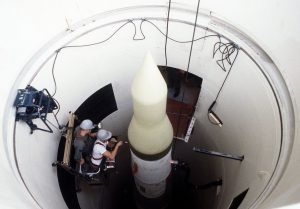
Multiple sources indicate the FY2021 budget request from the Trump Administration will seek a dramatic increase in funding for nuclear weapons—an unprecedented leap of 20% over current spending levels, bringing the total for The National Nuclear Security Administration to $20 billion. Reportedly, the increase is earmarked principally for modernization programs for warhead design and plutonium pit manufacturing facilities.
The Alliance for Nuclear Accountability released a letter to Congressional leadership calling for a hard look at the budget request when it arrives, scheduled for February 10, and encouraging House and Senate members to reject the increase as unjustified and unwise.
“So as this evolved over time, nuclear deterrence and nuclear war fighting became almost indistinguishable — and that’s the rabbit hole that some presidents in times of crisis have tried to scramble out of. Once you accept a couple of premises, you can get caught down this rabbit hole very quickly, where it almost becomes an inevitable thing that you end up using these weapons…”
— Quote from “The Bomb: Presidents, Generals, and the Secret History of Nuclear War,” by Fred Kaplan
Trump will seek 20% budget boost for nukes, says Inhofe
This “boost” will surely be reflected in the FY 2021 budget to be released February 10. The nuclear weapons increase is believed to be for new warheads (so-called Life Extension Programs) and expanded plutonium pit production. To pay for it, nonproliferation, dismantlement and cleanup programs are likely at risk.
BY: JOE GOULD | defensenews.com
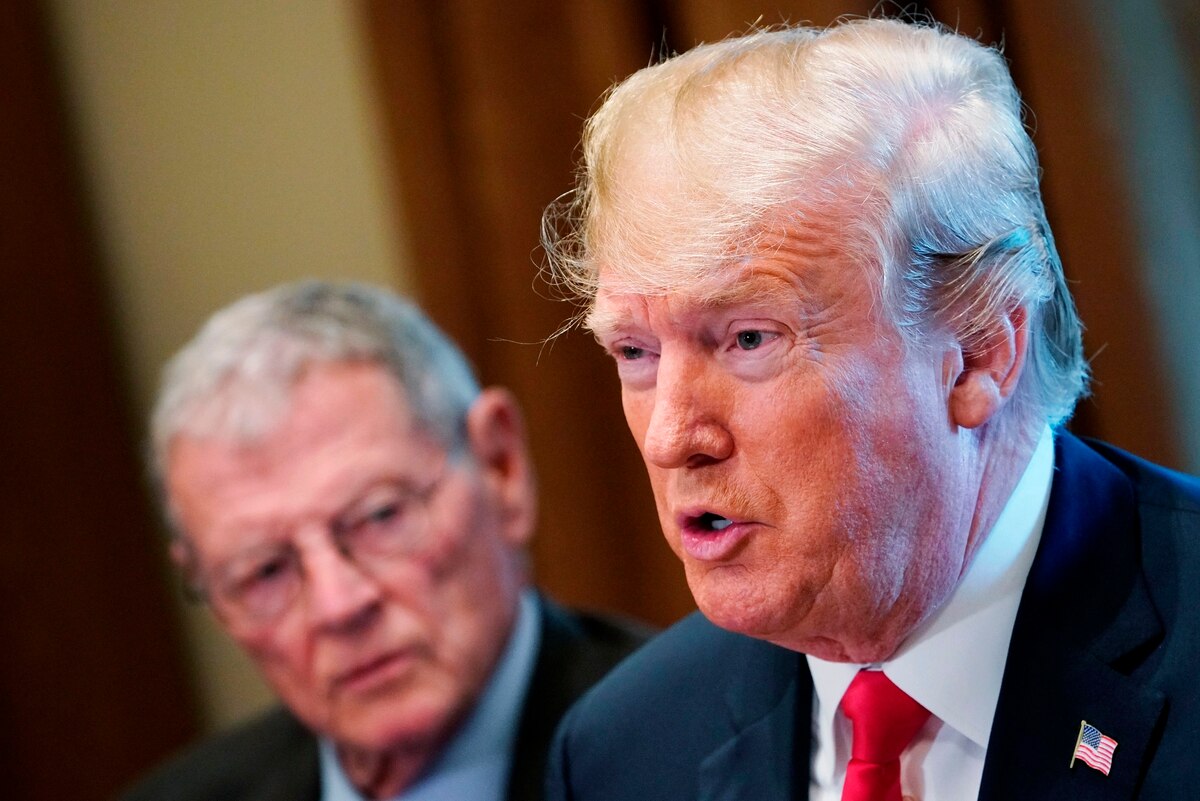
WASHINGTON ― U.S. President Donald Trump has settled an internal battle over whether to seek $20 billion for the federal agency that maintains America’s weapons, or less money, Senate Armed Services Committee Chairman Jim Inhofe, R-Okla., confirmed Tuesday.
The president will ask for the $20 billion.
The decision came after the head of the National Nuclear Security Administration, Lisa Gordon-Hagerty, agitated internally in favor of boosting the budget for nuclear weapons modernization in fiscal 2021 ― a position later backed by Inhofe and other congressional Republicans.
2019
9 LANL waste containers denied shipment to WIPP
Barrels filled with transuranic waste fail inspection, remain at lab’s Plutonium Facility
BY TRIS DEROMA | lamonitor.com
DNSFB reports: https://www.dnfsb.gov/sites/default/files/document/18696/Los%20Alamos%20Week%20Ending%20July%2026%202019.pdf
Nine containers full of transuranic waste are stuck at the Los Alamos National Laboratory’s Plutonium Facility after the Carlsbad Waste Isolation Pilot Plant refused to take them in back in July.
The containers, which hold waste items such as gloves, tools and other items that have come into contact with radiological materials, were scheduled to be shipped to WIPP during the week of July 26.
The Department of Energy’s contractor N3B that operates WIPP inspected the drums at LANL prior to the shipping date and determined that the drums contained materials that could combust.
N3B Spokesman Todd Nelson said that there was never a chance the containers would have made it to WIPP in the condition they were in.
September 3 Barbara Slavin, Director of the Future of Iran Initiative at the Atlantic Council, joins Joe Cirincione to discuss increasing tensions in the Middle East and the effects of Trump administration’s ‘maximum pressure’ campaign toward Iran.
Michelle Dover hosts Early Warning with Joe Cirincione and Tom Collina on the anniversary of the USSR’s first nuclear test. Michelle Dover and Joe Cirincione answer a question from Patrick about who in the US government is taking current nuclear weapons risks seriously.
Listen, Subscribe and Share on iTunes · Spotify · SoundCloud · YouTube · Google Play · Sticher
Also available on ploughshares.org/pressthebutton
Younger retiring as director of Sandia Labs
Sandia National Laboratories Director Steve Younger is retiring after two years on the job.
BY SCOTT TURNER / JOURNAL STAFF WRITER | abqjournal.com August 27, 2019
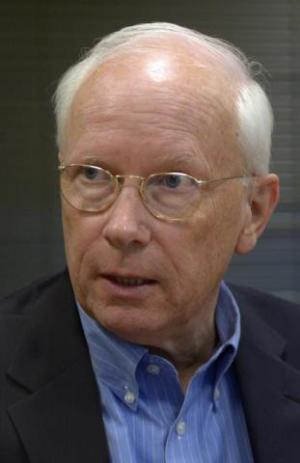
Younger told employees at the labs in an email Monday, saying he informed the National Technology and Engineering Solutions Board of Managers of his intent to retire on Dec. 31.
“The Board is actively engaged in a systematic search for my successor,” he said in the email.
Younger, 67, took the helm at Sandia on May 1, 2017, as the lab changed management for only the second time in its history. Younger has led the management entity NTESS of Sandia, a wholly owned subsidiary of Honeywell International, which took over from Lockheed Martin.
“Since arriving at the laboratories, I have been truly impressed with the impact that you have on the security of our nation and the world,” Younger told employees.
Younger said his role as a nuclear weapons researcher has made him keenly aware of the need to understand conflict avoidance.
Proposed New Exhaust at WIPP Designed to Release Radiation
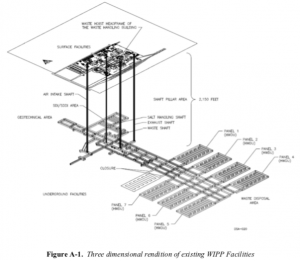
19 seconds – the amount of time airborne radiological contamination could be released before the safety dampers close. This assumes that all other components work perfectly.
A recent report from the Defense Nuclear Facilities Safety Board (DNFSB) explains the DNFSB’s calculations on the proposed new (estimated at nearly $300 million) safety significant confinement ventilation system (SSCVS).
The New Nuclear Arms Race Is Here. And Russia’s Already Paying the Price.
Meet 4 new nuclear weapons systems the Kremlin is testing — right now.
BY GREG WALTERS | vice.com
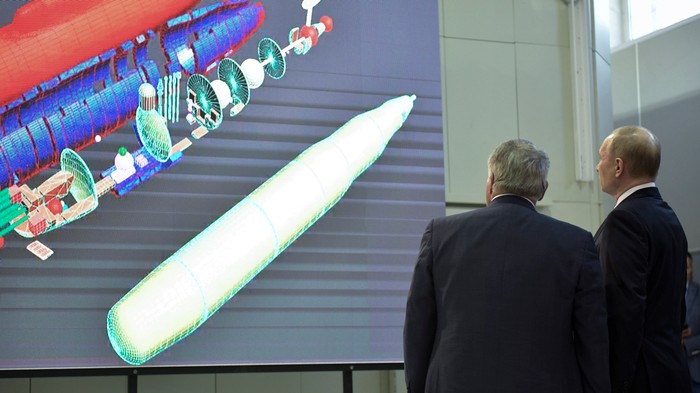
At the funeral for 14 Russian sailors, Captain Sergei Pavlov hailed the “blameless heroes” for dousing the fire that broke out on their nuclear spy submarine, called the Losharik, during a secret mission last month.
“At the cost of their lives,” Pavlov said, “they prevented a catastrophe on a planetary scale.”
But as Russia tests and deploys an array of exotic new nuclear weapons, fears are mounting that the next nuclear mishap may not be so easily contained.
This summer alone, Russia has suffered some two-dozen casualties in accidents related to exotic nuclear hardware, including the mysterious explosion linked to the Skyfall missile program that killed seven and sent local radiation levels spiking in a nearby city.
The deadly incidents are stoking fears of a return to Cold War-style runaway nuclear arms development, accompanied by dangerous accidents and Soviet-style cover-ups.
“We need to acknowledge that the Russians are engaged in wacky programs,” said Aaron Stein, a nuclear nonproliferation expert at the Foreign Policy Research Institute. “It’s indicative of an arms complex that has been cut loose to pursue exotic, silly projects. And it’s dangerous.”
You can blame the renewed U.S.-Russian arms race, which nuclear experts warn is driving Russia to recklessly experiment with “absurd” new ideas.
On 29 August, the International Day against Nuclear Tests, Kazakhstan deposited its instrument of ratification for the Treaty on the Prohibition of Nuclear Weapons, becoming the 26th state party.
From 1949 to 1989, an estimated 456 Soviet nuclear tests — including 116 atmospheric tests — were carried out at the Semipalatinsk test site in Kazakhstan, with devastating long-term consequences for human health and the environment.
Upon the break-up of the Soviet Union, Kazakhstan inherited approximately 1,400 nuclear warheads, which it subsequently gave up — recognizing that its security was best achieved through disarmament.
The date of 29 August 2019 has special significance for Kazakhstan. It marks 70 years since the first Soviet nuclear test at the Semipalatinsk site and 28 years since the formal closure of that site.
We congratulate Kazakhstan on its ratification and we acknowledge the persistent efforts of Alimzhan Akhmetov, of the Center for International Security and Policy in Kazakhstan, to encourage the Kazakh government to take this important step.
Pakistan ups nuclear rhetoric, carries out launch of ballistic missile
BY AJAY BANERJEE | tribuneindia.com Tribune News Service New Delhi August 29, 2019
Pakistan has successfully test-fired surface-to-surface ballistic missile ‘Ghaznavi’, capable of delivering multiple warheads up to 290 km, the Army said on Thursday, amid fresh Indo-Pak tensions after India revoked Jammu and Kashmir’s special status.
Pakistan on Wednesday closed three aviation routes of the Karachi airspace till August 31, which had promoted speculation about the possible missile-testing.
Pakistan successfully carried out night training launch of surface to surface ballistic missile Ghaznavi, capable of delivering multiple types of warheads upto 290 KMs. CJCSC & Services Chiefs congrat team. President & PM conveyed appreciation to team & congrats to the nation. pic.twitter.com/hmoUKRPWev
— DG ISPR (@OfficialDGISPR) August 29, 2019
With this, Pakistan upped its ‘nuclear rhetoric’. The Director General of Inter Service Public Relations (DG-ISPR) said Pakistan on Wednesday night tested a short range nuclear missile in Sindh.
France Is Still Cleaning Up Marie Curie’s Nuclear Waste
Her lab outside Paris, dubbed Chernobyl on the Seine, is still radioactive nearly a century after her death.
BY TARA PATEL | bloomberg.com

In 1933 nuclear physicist Marie Curie had outgrown her lab in the Latin Quarter in central Paris. To give her the space needed for the messy task of extracting radioactive elements such as radium from truckloads of ore, the University of Paris built a research center in Arcueil, a village south of the city. Today it’s grown into a crowded working-class suburb. And the dilapidated lab, set in an overgrown garden near a 17th century aqueduct, is sometimes called Chernobyl on the Seine.
No major accidents occurred at the lab, which closed in 1978. But it’s brimming with radioactivity that will be a health threat for millennia, and France’s nuclear watchdog has barred access to anyone not wearing protective clothing. The lab is surrounded by a concrete wall topped by barbed wire and surveillance cameras. Monitors constantly assess radiation, and local officials regularly test the river.
“We’re proof that France has a serious nuclear waste problem,” says Arcueil Mayor Christian Métairie. “Our situation raises questions about whether the country is really equipped to handle it.”
Nuclear power accounts for almost three-fourths of France’s electricity, vs. a fifth in the U.S. There’s no lasting solution for the most dangerous refuse from the country’s 906 nuclear waste sites, including some of what’s in Arcueil.
2018
NNSA Releases Draft Environmental Assessment for LANL Rad Lab; Raises Plutonium Limit 10 Times for Expanded Pit Production
Santa Fe, NM.
Today the National Nuclear Security Administration announced an Environmental Assessment to increase the amount of plutonium used in the Radiological Laboratory Utility and Office Building (aka the “Rad Lab”) at the Los Alamos National Laboratory from 38.6 grams of plutonium-239 equivalent to 400 grams. This 10-fold increase is significant because it will dramatically expand materials characterization and analytical chemistry capabilities in the Rad Lab in support of expanded plutonium pit production for future nuclear weapons designs. It also re-categorizes the Rad Lab from a “radiological facility” to a “Hazard Category-3” nuclear facility.
WIPP Could Get $79M Budget Increase Under Trump’s DOE Funding Proposal
“The potential increase would mark a $79 million boost in WIPP’s funding compared with enacted spending in FY 2017, while several infrastructure projects are ongoing at the site to increase airflow and continue to expand the facility’s underground nuclear waste repository.”
Trump’s Budget Dramatically Increases Nuclear Weapons Work
In keeping with the Trump Administration’s recent controversial Nuclear Posture Review, today’s just released FY 2019 federal budget dramatically ramps up nuclear weapons research and production.
The National Nuclear Security Administration (NNSA), the Department of Energy’s semi-autonomous nuclear weapons agency, is receiving a $2.2 billion overall boost to $15.1 billion, a 17% increase above the FY 2018 enacted level. Of that, a full $11 billion is for the budget category (Nuclear) “Weapons Activities”, 18% above the FY 2018 level.
Digging deeper under Weapons Activities, “Directed Stockpile Work” is increased from $3.3 billion to $4.7 billion, or 41%. Directed Stockpile Work is the hands on, nut and bolts operations that include extending the service lives of existing nuclear weapons for up to 60 years, while also endowing them with new military capabilities.
In addition, NNSA budget documents show “Weapons Activities (Reimbursable)” (parentheses in the original), adding another $1.76 billion to NNSA’s Nuclear Weapons Activities, for a total of $12.78 billion. It is not made clear where that additional money comes from, but most likely is from the Defense Department, as it has been in the past.
Of concern to the American taxpayer, DOE and NNSA nuclear weapons programs have been on the Government Accountability Office’s High Risk List for project mismanagement and fraud, waste and abuse since its inception in 1990.
Meanwhile, NNSA Nonproliferation Programs are budgeted at $1.86 billion, only 16% the size of the nuclear weapons budget. Further, the State Department is being cut by $10.4 billion to $28.3 billion (a 29% cut), while many senior diplomatic positions are left unfilled (such as the U.S. ambassador to South Korea), even as the possibility of peace on the Korean peninsula is breaking out.
The NNSA budget also reiterates the executive branch’s intent to terminate the Mixed Oxide (MOX) program, designed to “burn” military plutonium in commercial reactors. That program would introduce plutonium to the global market, contrary to its stated intent as a nonproliferation program. It has also been a debacle in terms of cost overruns, blown schedules and lack of contractor accountability, kept alive only by South Carolina congressional political pork interests.
However, the MOX program’s slow demise puts yet more pressure on New Mexico to become the nation’s radioactive waste dumping ground, with up to 35 tons of military plutonium potentially headed for the Waste Isolation Pilot Plant (which already lacks capacity for currently scheduled wastes). In addition, the Trump budget increases funding for so-called interim storage of spent nuclear fuel rods, the nation’s deadliest high-level radioactive wastes. There are two separate proposals for “interim” storage of 100 tons of spent nuclear fuel in either southern New Mexico or just on the other side of the border with Texas.
The Waste Isolation Pilot Plant (WIPP) received an increase to $397 million, $106 million above the FY 2018 level. This starts the expansion of WIPP with a new ventilation shaft that has silently morphed from replacing the old contaminated exhaust shaft into being an additional intake shaft. Plans are underway for a new filter building, which will replace the capabilities lost due to the 2014 radiological release caused by an improperly prepared radioactive waste drum from the Los Alamos Lab. That closed WIPP for nearly three years, costing the American taxpayer at least $1.5 billion to reopen. The planned new intake shaft will greatly increase WIPP”s capabilities, allowing for expansion to take more of the nation’s radioactive wastes.
The cleanup request for Los Alamos National Laboratory (LANL) stays flat at $192 million. The basis for this is DOE’s woefully low lifecycle cost estimate for LANL cleanup, which in turned is predicated upon the New Mexico Environment Department’s revised cleanup Consent Order. Under Governor Susana Martinez, the revised Consent Order allows DOE and LANL to fund so-called cleanup at levels they choose, rather than needed cleanup driving the funding.
The Los Alamos Lab explicitly plans to leave permanently buried 200,000 cubic yards of radioactive and hazardous wastes in unlined pits and trenches, above our groundwater and three miles uphill from the Rio Grande. Once those wastes are “capped and covered”, LANL plans to claim that “cleanup” is completed.
Finally, under Trump’s budget, the Department of Energy cuts sustainable transportation, renewable energy and energy efficiency by 33% and zeroes out weatherization programs.
Jay Coghlan of Nuclear Watch commented,
The Trump budget prepares for nuclear war, in which even Ronald Reagan said there can’t be any winners. It finances a new Cold War arms race with Russia and indirectly increases the chances of a nuclear war with North Korea. It sets back nonproliferation and cleanup programs, and further hollows out our country by diverting yet more huge sums of money to the usual fat cat nuclear weapons contractors. Come November, voters should vote their conscience over how the federal government under Trump prioritizes their tax dollars for good or ill.
# # #
Nuclear Watch New Mexico will provide more budget information on our web site www.nukewatch.org and blog www.nukewatch.org/watchblog as it becomes available. The available budget documents are still not detailed enough for new issues and programs that we are keenly interested in, such as new, more usable mininukes and expanded plutonium pit production at LANL.
Trump’s Budget Dramatically Increases Nuclear Weapons Work
Santa Fe, NM
In keeping with the Trump Administration’s recent controversial Nuclear Posture Review, today’s just released FY 2019 federal budget dramatically ramps up nuclear weapons research and production.
The National Nuclear Security Administration (NNSA), the Department of Energy’s semi-autonomous nuclear weapons agency, is receiving a $2.2 billion overall boost to $15.1 billion, a 17% increase above the FY 2018 enacted level. Of that, a full $11 billion is for the budget category (Nuclear) “Weapons Activities”, 18% above the FY 2018 level.
Digging deeper under Weapons Activities, “Directed Stockpile Work” is increased from $3.3 billion to $4.7 billion, or 41%. Directed Stockpile Work is the hands on, nut and bolts operations that include extending the service lives of existing nuclear weapons for up to 60 years, while also endowing them with new military capabilities.
Trump: On the US Nuclear Arsenal
“We’re modernizing and creating a brand new nuclear force. And frankly, we have to do it because others are doing it. If they stop, we’ll stop. But they’re not stopping. So, if they’re not gonna stop, we’re gonna be so far ahead of everybody else in nuclear like you’ve never seen before. And I hope they stop. And if they do, we’ll stop in two minutes. And frankly, I’d like to get rid of a lot of ’em. And if they want to do that, we’ll go along with them. We won’t lead the way, we’ll go along with them…
But we will always be number one in that category, certainly as long as I’m president. We’re going to be far, far in excess of anybody else.”
For more see Politico
Pence Snubs Peace Initiative at Winter Olympics
Experts have been saying for some time that there is no good military solution to the Korea crisis. The best way to see the crisis defused would, of course, start with a rapprochement of the two Koreas. In fact the State Dept. recently said that the US would have no objection to a unified Korea as long as it was de-nuclearized. So that path was in the wind, but when the two Koreas initiated a peace and reconciliation effort at the Olympics, US Vice President Pence refused to go along.
Pence spent the days leading up to Friday’s opening ceremonies warning that the North was trying to ‘hijack the message and imagery of the Olympic Games’ with its ‘propaganda.’
But the North was still welcomed with open arms to what South Korean President Moon Jae-in called ‘Olympic games of peace’ and the U.S. appeared to be the one left out in the cold.
Pence sat stone-faced in his seat as Moon and North Koreans officials stood together with much of the stadium to applaud their joint team of athletes. White House officials stressed that Pence had applauded only for the American team, but Asia experts said the vice president’s refusal to stand could be seen as disrespectful to the hosts.
While South Korean President Moon did not hesitate to shake hands and smile with his North Korean visitors, Pence didn’t appear to even look in the direction of the North Korean delegation during the Friday event.
Seems the Trump administration would rather threaten than talk.
Pence’s Anti-North Korea PR Campaign Bombs
US Vice-President Mike Pence rains on Olympic parade with Korea team snub
Testimony Calls Out Continued DOE Cost Estimating Mismanagement
Testimony Calls Out Continued DOE Cost Estimating Mismanagement
Given that DOE has challenges estimating almost all large projects, taxpayers must push to spend on cleanup first. Both nuclear weapons and environmental management estimates keep increasing. We can keep spending on dangerous nuclear weapons that we don’t need, or we can finally focus on cleaning up the Cold War mess.
Government Accountability Office (GAO) officials presented some of their recent work to Congress concerning management problems facing the Department of Energy’s (DOE) National Nuclear Security Administration (NNSA) and Office of Environmental Management (EM). NNSA is responsible for managing the nation’s nuclear weapons and supporting the nation’s nuclear nonproliferation efforts. In support of these missions, NNSA’s February 2016 budget justification for the Weapons Activities appropriations account included about $49.4 billion for fiscal years 2017 through 2021 to implement its nuclear weapons complex modernization plans. More recently, in November 2017, NNSA issued its Stockpile Stewardship and Management Plan, which included about $10.2 billion for nuclear weapons activities for fiscal year 2018.
Since the end of the Cold War, it is claimed that much of the nuclear weapons production infrastructure has become outdated, prompting congressional and executive branch decision makers to call on DOE to develop plans to modernize. The Department of Defense’s (DOD) 2010 Nuclear Posture Review identified long-term modernization wishes and alleged requirements. In January 2017, the President directed the Secretary of Defense to initiate a new Nuclear Posture Review to meet the Administration’s vision. This review was released in February 2018.
GAO has found that NNSA’s estimates of funding needed for its modernization plans exceeded the budgetary projections included in the President’s own modernization budgets. And the costs of some major modernization programs—such as for nuclear weapon Life Extension Programs (LEPs) — may also increase and further bust future modernization budgets.
The LEPs facing potential cost increases include:
B61-12 LEP. An independent cost estimate for the program completed in October 2016 exceeded the program’s self-conducted cost estimate from June 2016 by $2.6 billion.
W80-4 LEP. Officials from NNSA’s Office of Cost Policy and Analysis told us that this program may be underfunded by at least $1 billion to meet the program’s existing schedule
W88 Alteration 370. According to officials from NNSA’s Office of Cost Policy and Analysis, this program’s expanded scope of work may result in about $1 billion in additional costs.
EM is responsible for decontaminating and decommissioning nuclear facilities and sites that are contaminated from decades of nuclear weapons production and nuclear energy research. In February 2017, GAO reported that, since its inception in 1989, EM has spent over $164 billion on cleanup efforts, which include retrieving, treating, and disposing of nuclear waste.
GAO found that the federal government’s environmental liability has been growing for the past 20 years—and is likely to continue to increase—and that DOE is responsible for over 80 percent ($372 billion) of the nearly $450 billion reported environmental liability. Notably, this estimate does not reflect all of the future cleanup responsibilities that DOE may face.

As NNSA works to modernize the nuclear weapons complex, EM is addressing the legacy of 70 years of nuclear weapons production. These activities generated large amounts of radioactive waste, spent nuclear fuel, excess plutonium and uranium, and contaminated soil and groundwater. They also contaminated thousands of sites and facilities, including land, buildings, and other structures and their systems and equipment. Various federal laws, agreements with states (including New Mexico), and court decisions require the federal government to clean up environmental hazards at federal sites and facilities, such as nuclear weapons production facilities. For years, GAO and others have reported on shortcomings in DOE’s approach to addressing its environmental liabilities, including incomplete data on the extent of cleanup needed.
EM has some budget issues, too.
Examples of costs that DOE cannot yet estimate include the following:
DOE has not yet developed a cleanup plan or cost estimate for the Nevada National Security Site and, as a result, the cost of future cleanup of this site was not included in DOE’s fiscal year 2015 reported environmental liability. The nearly 1,400-square-mile site has been used for hundreds of nuclear weapons tests since 1951. These activities have resulted in more than 45 million cubic feet of radioactive waste at the site. According to DOE’s financial statement, since DOE is not yet required to establish a plan to clean up the site, the costs for this work are excluded from DOE’s annually reported environmental liability.
DOE’s reported environmental liability includes an estimate for the cost of a permanent nuclear waste repository, but these estimates are highly uncertain and likely to increase. In March 2015, in response to the termination of the Yucca Mountain repository program, DOE proposed separate repositories for defense high-level and commercial waste. In January 2017, we reported that the cost estimate for DOE’s new approach excluded the costs and time frames for site selection and site characterization.
Govt pulls full Nuclear Posture Review – Get it here!
The old link for the full Nuclear Posture Review
live on Friday February 2, 2018, now yields nothing.
The Defense Department’s new link
https://www.defense.gov/News/Special-Reports/0218_npr/
has an executive summary and some fact sheets, but not the full Review.
Interestingly, the executive summary looks like it’s translated into Russian, Chinese, Japanese, Korean and French. No doubt people around the world are looking at it.
But you now can find the full Nuclear Posture Review at
https://nukewatch.org/importantdocs/resources/2018-NUCLEAR-POSTURE-REVIEW-FINAL-REPORT.PDF
That won’t go away!
“Gateway Drug to Nuclear War” Feeds More Nuke Addiction
“Gateway Drug to Nuclear War” Feeds More Nuke Addiction
The Trump Administration’s high policy document, the Nuclear Posture Review (NPR), released February 2, includes recommendations for the deployment of lower yield, “more usable” nuclear warheads. This will only feed the US addiction to nukes.
An article on the same day in The American Conservative, “Trump’s Nuke Plan Raising Alarms Among Military Brass”, quotes one retired senior Army officer who tracked the NPR as saying that nuclear neocons were providing Donald Trump with “gateway drug for nuclear war.”
So while the [NPR’s] recommendations won’t necessarily be a surprise, what is less public is the bitter battle during its drafting that pitted senior Army and Navy warriors against nuclear wonks inside the Defense Department. That fight—over the exorbitant costs associated with the NPR, and charges that it could make nuclear war more likely—are bound to continue through implementation.
“It’s one thing to write a policy,” a senior Pentagon civilian privy to the NPR fight told The American Conservative, “and it’s another thing to have it implemented. What the NPR is recommending will break the bank, and a lot of people around here are worried that making nuclear weapons more usable isn’t what we should be doing. The conventional military guys have dug in their heels, they’re dead-set against it. This battle isn’t over.”
In effect, the congressionally mandated review calls for the U.S. to deploy two new types of lower yield nuclear warheads, generally defined as nuclear bombs below a five kiloton range (the one dropped on Hiroshima was 20 kilotons), that could be fitted onto a submarine-launched ballistic missile, and one, yet to be developed, that would be fitted onto a submarine-launched cruise missile. Additionally, the NPR calls for “recapitalizing” the complex of nuclear laboratories and plants, which, taken together with the proposed modernization program of the U.S. nuclear arsenal (the “triad”), will almost certainly cost in excess of the estimated price tag of $1.2 trillion over the next 30 years.
The article continues that Army and Navy officers worry that senior administration officials would promote massive new funding initiatives at the expense of badly needed funding for conventional military readiness. They also worry, more urgently, that the administration would put the nation on the slippery slope to nuclear escalation.
NukeWatch’s bottom line: Addiction to nukes is a potentially world-ending problem.
Trump’s Nuclear Posture Review goes in the opposite direction of meeting our long-term need to eliminate the one class of weapons of mass destruction that can truly destroy our country. It will instead set back nonproliferation and arms control efforts across the globe, and further hollow out our country by diverting yet more huge sums of money to the usual fat defense contractors at the expense of public education, environmental protection, natural disaster recovery, etc. Under the Trump Administration, expect Medicare and Social Security to be attacked to help pay for a false sense of military security. Trump’s Nuclear Posture Review is part and parcel of that.
Nuclear Watch New Mexico seeks to promote safety and environmental protection at nuclear facilities; mission diversification away from nuclear weapons programs; greater accountability and cleanup in the nation-wide nuclear weapons complex; and consistent U.S. leadership toward a world free of nuclear weapons. Please help support NukeWatch.
2005 Consent Order
The 2005 consent order was LANL’s agreement for “fence-to-fence” cleanup of Cold War-era legacy waste by December 2015. Issued pursuant to the New Mexico Hazardous Waste Act, the Consent Order set the requirements for a comprehensive investigation of environmental contamination and provides for the identification of cleanup alternatives and the implementation of cleanup measures. (NMED, DOE, UC Regents)
2017
Nothing Found
It seems we can’t find what you’re looking for. Perhaps searching can help.
2016
Nothing Found
It seems we can’t find what you’re looking for. Perhaps searching can help.
2015
Nothing Found
It seems we can’t find what you’re looking for. Perhaps searching can help.

